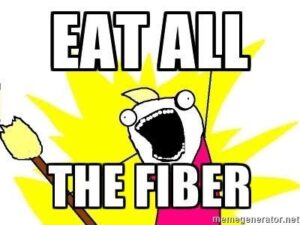Eating all the fiber would be an absolute DISASTER… for both your toilet and your bum. But, what would be even more of a disaster is NOT using the toilet every day. Ain’t nobody got time for that and the bloating that accompanies not going #2. Irregularity is one of the worst feelings, especially right before you go for a heavy squat at the gym.

Yes, I’m talking about poop. (I totally went there.) If you dislike talking, reading, or even thinking about poop, then save yourself now by scrolling down to the section marked “Ideal Fiber Sources,” below the next meme. (Poop memes are the best.)
We all know how miserable it feels to not go #2 during the day. Grumpiness, moodiness, and general irritability ensue, not to mention your stomach just doesn’t feel “normal.” You just feel “off” all day. Then, when you do manage to doo, it feels as though the heavens part and cherubs begin rejoicing in your accomplishment. (Is it just me who feels that way? Mmmkay… cool.)
Enter our friend, fiber. Fiber is critical to our overall wellness, particularly our digestive health. Fiber not only helps with intestinal motility, but it may help prevent many diseases and issues (here’s some supportive research). Ladies and/or smaller individuals should aim for a minimum of 25g of fiber per day, while guys or larger individuals regardless of sex should aim for a minimum of 30-35g – more simply put, you should aim for around 10g of fiber for every 1,000 calories you consume. A great minimum to strive for is 25g daily, regardless of overall caloric intake.
Even though fiber leaves us feeling full (in a good way), along with providing us with a boost to go to the bathroom, there’s actually such a thing as eating too much fiber — this number is estimated to be around 60g (but keep in mind that is only an estimate). The reason 60g is estimated as an upper limit for fiber is because that is the point when fiber starts to prevent the absorption of nutrients from our food within our intestines.
Keep in mind that everyone responds differently to fiber. You may find that you get uncomfortable when you consume over 40g, and that’s perfectly fine. If you find this to be the case for you, then just eat to the point of comfort in relation to your minimum fiber level.
Your take away from this: Aim for your daily fiber goal, but also listen to your body and don’t overdo it. Find that “happy medium” for you.

Don’t be like this guy — choose to eat whole food fiber sources first, then you can turn to fiber supplements or bars to fill-in any gaps.
IDEAL FIBER SOURCES (no more mention of poop)
Here are some ideas for excellent fiber sources when you are in a pinch to pinch. These serving sizes and macros are from calorieking.com and MyFitnessPal. NOTE: Some sources can be higher in carbs, proteins, and fats than others, so pay attention to these variations.
Veggies! (Brussels sprouts, and almost any other veggie — macros vary)
Raspberries (100g of berries = 6.5g fiber / 11.9g carbs)
Blackberries (100g of berries = 5.3g fiber / 9.6g carbs)
Blueberries (100g serving = 2.4g fiber / 14.5g carbs)
Strawberries (100g serving size = 2g fiber / 7.7g carbs)
Apples with skin (100g serving = 2.4g of fiber / 13.8g of carbs)
Asian pears with skin (100g serving = 3.6g fiber / 10.6g carbs)
Bananas (100g serving = 2.6g fiber / 22.8g of carbs)
Figs (100g serving = 2.9g fiber / 19.2g carbs)
Acorn squash (100g serving = 1.5g fiber / 10.4g carbs)
Potatoes (sweet, white, yellow, with the skin still on: 100g serving of baked sweet potatoes = 3.3g fiber / 20.7g carbs)
Nuts (100g of almonds = 12.5g fiber / 21.5g carbs / 49.9g fat / 21.1g protein — this is a really large portion!)
Chia seeds (1 oz serving = 10g fiber / 10g carbs / 6g protein / 6g fat)
Flax seeds (1 oz serving = 10g fiber / 16g carbs / 6g protein / 6g fat)
Black beans (100g serving = 6.6g fiber / 14.8g carbs / 5.7g protein / 0g fat)
Any kind of beans (kidney, red, navy, etc.)
Lima beans (100g serving = 4.8g fiber / 14.9g carbs / 4.9g protein / 0g fat)
Lentils (1 oz serving = 2g fiber / 5g carbs / 2.2g protein / 0g fat)
Chickpeas (1 oz serving = 4.4g fiber / 16g carbs / 4.8g protein / 1.6g fat
Avocado (100g serving = 6.7g fiber / 8.5g carbs / 2g protein / 14.7g fat)
Quinoa (100g serving = 5.9g fiber / 68.9g carbs / 13.1g protein / 5.8g fat)
Vita cakes and muffin tops (found in the frozen dessert or health food section — about 5-8g fiber per serving)
FiberOne brownies or bars (usually about 5-8g of fiber per serving)
Find that happy medium for you.
I hope this list helps you learn about some new sources of fiber to fit into your day. As always, add a comment below or shoot me a message if you have any questions.
Deuces (pun intended)
INTERESTED IN LEARNING MORE?
Interested in learning more about flexible eating and how to eat enough fiber? Comment below or email me, and I’d be more than happy to help you make sense of it all.
If you’re interested in having your macronutrients personally calculated for you to meet your goals, or having a customized nutrition plan built just for you and paired with attentive coaching, then check-out my Services page first to see what I offer. Message me and we can arrange a time to chat for a free consultation.


